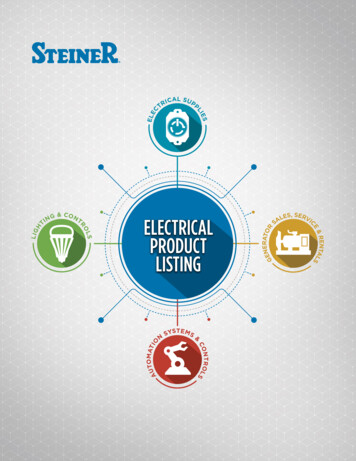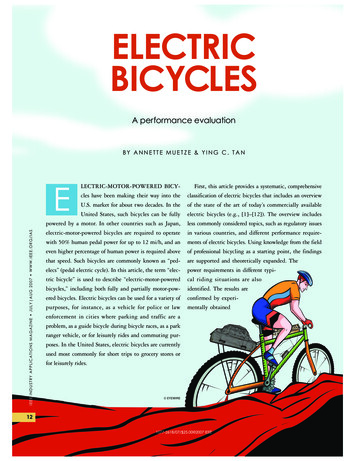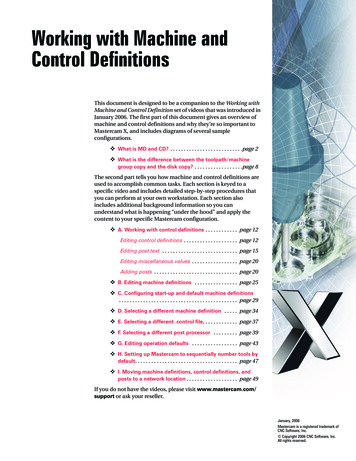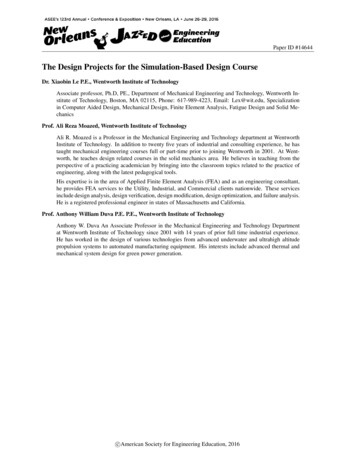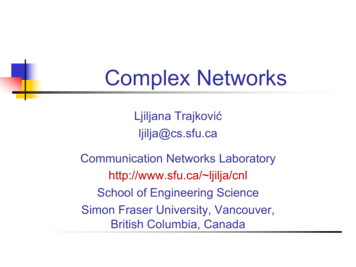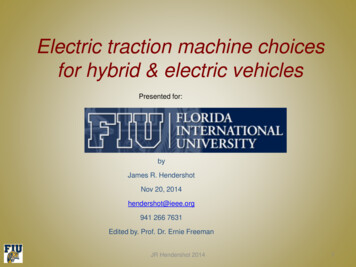
Transcription
Electric traction machine choicesfor hybrid & electric vehiclesPresented for:byJames R. HendershotNov 20, 2014hendershot@ieee.org941 266 7631Edited by. Prof. Dr. Ernie FreemanJR Hendershot 20141
Early electric cars in USAAllison driving earlyFord-Edison carEdison’s 1896electric quadricycle100 miles percharge!!!1913 Edisonelectric carJames Hendershot 20142
As we approach 2015 there are a bunch of Hybrids or plug-insbeing produced around the world with many more to comePorsche SE-HYBRIDMercedes-Benz B-Class Electric DriveVW JETTASonata HybridBMW i3Nissan LeafJames Hendershot 20143
Largerair-gapSmallerair-gapTwo most popularvehicle tractionmotor choicesBrushlessstator designtypical of anAC InductionmachineJames Hendershot 20144
Abstract:“Electric traction machine choices for hybrid & electric vehicles”How and why did the design engineers decide which electric machine type todevelop for modern hybrid & pure electric vehicles? Similar machine typesseem to be used in all hybrids. The all electric vehicles have been developedusing a different machine topology. This presentation reviews the Toyota PriusHybrid vehicle and many that followed to gain insight to this question.It is the author’s desire the engineers interested in vehicle traction motor designand selection will come away with a clear understanding of the choices, sometradeoffs and a starting place in mind for their own efforts.Many photographs and details are presented for the drive train of nearly everysuch vehicle currently in production. Knowledge of what has been done beforemakes sure that re-invention is avoided.“In order to be a creator of progress It is better to stand on the shoulders ofthose before you to enable you to see over their heads into the future”Paraphrased from Isaac Newton”JR Hendershot 20145
17 years have now passed now since Toyota came out with the first Prius(One year after the GM EV-1)General Motors came out with the first production electric vehicle in 1996Going back further, Thomas Edison came out with an electric car in 1895Interesting results since 1996 (date of first Prius)Only production car using an AC Induction motor for traction is the TESLAGM Volt rumored to use both an IPM and and AC induction motor for VOLTAll other hybrids and electric cars in production use IPMsSo my advice to you all is “don’t re-invent any old motor concepts but onlyuseful modifications of them or better still, new designs. Therefore we musthave a quick look at the current electric cars and/or their electric motors to seewhat has already been done to make sure you drive on the right road !!JR Hendershot 20146
Toyota Prius(3,166,000 sold from1997 through mid 2013)1997Rated 33 kW @ 4500 rpmMax motor speed 5600 rpmBattery voltage 288 VDCDC to DC boost to 500 VDCPeak torque 350 Nm2003Rated 50 kW @ 1200 to 1540 rpm33 kW 1040 to 6,000 rpm max.Battery voltage 201.6 VDCDC to DC boost to 500 VDCPeak torque rating 400 NmJR Hendershot 20142009Rated 60 kW @ ? rpmMax motor speed 13,500 rpmBattery voltage 201.6 VDCDC to DC boost to 650 VDCPeak torque rating 207 Nm7
Comparison of Toyota, 2010 Prius, LS600 Lexus, Camry and 2004 Priuscopyright, 2014, J R Hendershot8
Toyota has used such FEA simulation techniques to constantly improvetheir IPM designs for their Hybrid cars. Some examples shown below:Toyota 2010PriusJR Hendershot 2014new webretention9
1996 GM EV-1Traction motor3 phase AC Induction, aluminum rotorMotor speed0 to 7000 rpmRated output power102 kW (137 hp)Torque from 0 to 7 krpm 149 Nm (110 lbf-ftFixed gear ratio with no transmissionOriginal batteries “Deep cycle lead acid”, 312 VDC, 100 mile rangeDelco-Remy “NiMH batteries”, 343 VDC, 160 mile rangeAcceleration 0 to 60 mph 8 sec (Max speed 80 mph)JR Hendershot 201410
Toyota rotor & stator lamination cross section evolution1997 Rotor2003 RotorJR Hendershot 2014Notice the magnet designchanges & center retentionwebs in 2007 Camry, 2008Lexus & 2009 Prius.(Very good design reasons)11
Lets have a peek at some of these unique motor designsFord EscapeChevy VOLTNote:It appears that many automobilemanufactures have elected todesign their motors and drives inhouse rather than working withexisting electric motor companies.BMW i3JR Hendershot 201412
Ford electric traction motor details (Escape, Focus or Fusion?)8 pole rotor16 magnetsFord Focus 123 HP (92 kw)(8) Pole IPM RotorCopper end ringsor balance rings?JR Hendershot 2014Hi slot fill (70%)13
GM VOLT originally usedthe REMY 10 poledouble layered IPMmotor with a hairpinwound statorvoltage 700Output torque 170 NmOutput power 150 kWMax speed 10,000 rpmThere is also an aluminum rotor ACInduction motor used in the VoltWork continues by REMY & GM toconvert its rotor to a copper rotorJR Hendershot 201414
Chevy VOLT electric traction motor detailsFINISHEDSTATOR10 pole IPMRotor &Stator40 magnetsHair-Pin windingsHi slot fill using square wireJR Hendershot 201415
According to both REMY & GM, the 60 slot statorwith hair-pin windings can be used with either theIPM or the Caged rotorLoadedfield plotPM Pole DesignOptimizationPhase AJR Hendershot 201416
BMW i3 electric traction motor details (Landshut Germany)Motors/Drivespackaged for testPhase coilinsertion12 pole IPM rotorMagnet InserterEnd turn lacingStacking (5) rotor segmentsShed winderfor phase coilsBMW patent application Nº 2012/0267977Phase terminationJR Hendershot 2014Phase termination17
Quick view of various motors intended for vehicle tractionZEMOTERINGAVL HybridDriveHyundaiSonataEBusMercedes-Benz PU106A(15,000 rpm)YASAZYTEK 170 kwPorscheLEXUS2009 PorscheSUMOCayenneJR Hendershot 201418
Two SPM traction motorsMotors by Danaher(Pacific Scientific)JR Hendershot 201419
New people movers with one or two wheels 1200EN-VbyGeneralMotorsHonda U3-XRYNOMOTORSUNOJR Hendershot 201420
Increasing the number of poles (all machines)Increasing the number of poles decreases the motor OD and mass(assuming rotor O.D. does not change)Prof. W. L. Soong, U of AdelaidaJR Hendershot 201421
Optimum pole number for AC inverter driven machines014140140014000(Nm)Optimal pole numbers for AC inverter driven motorsFor most all traction motors the optimum number of poles 4 resulting in lowestleakage reactance, highest power factor and efficiencyIPMs do not have this limitation so all IPM traction motors are 8, 10 or 12 polesIPMs should be smaller and lower in mass than AC inductance machinesJR Hendershot 201422
The Tesla traction motor is a 4 Pole design.The IPM – AC brushless machines are synchronous motors with high polesThe Switched reluctance motor is a synchronous machine with high polesThe Reluctance Synchronous motor is sort of in between, although it is asynchronous machine the pole number can be 4, 6 or 8 for traction.Each machine has their pros and cons which we will not discuss here.Suffice to say that all types of motors with no magnets are on the tableJR Hendershot 201423
Same stator with three rotor choicescopyright, 2014, J R Hendershot24
Three rotor configurations usingsimilar stators and windings.All three machines areInverter fed for mostspecific requirementsIMRSMRPM sensorAnglesensorIPM or SPMSRMAnglesensorSR machines require, new stators& windings plus new half-bridgeinverter/control technologyJR Hendershot 2014Anglesensor25
A comparative graphic of electric machine choices for vehicletraction & accessory motors (Besides brushed PM DC)** NO RARE EARTHMAGNETS NEEDED** AC INDUCTIONPM-AC SYNCHRONOUS* *SWITCHED RELUCTANCE** RELUCTANCE SYNCHRONOUSJames Hendershot 201426
Easy automated AChigh slot fill statorHair-pin stator automatedwinding with high slot fill.(Can be round or rectangular)Applicable to all three machinetypes except SRJR Hendershot 201427
Doubly salient pole reluctance machines called Switched Reluctance (SRM)(Some have called the SRM, “the good, bad & ugly”!!)GOOD !The SRM is one of the oldest electric machines dating back to the middle19th century but not practical until the development of the transistor.Very simple in construction and low cost to manufactureSRMs are very robust and reliable with decent fault toleranceBAD !Tricky to control & requires custom half bridge power switching circuitsRequires double number of connections as other machinesRequires double the number of power switching devices of other machinesUgly !Tends to be noisy without special attention to designRequires careful commutation to minimize torque rippleJR Hendershot 201428
Examples of 3, 4 & 5 phase SR machine cross -phase12-85-phase10-6JR Hendershot 201429
Photos of 200 KW SR motor design by Dr. Sergie Kolomeitsevfor direct drive pump application, prototyped by a US company.Air-GapdetailsSR Motormountedon pump(3) phase 12-8 SRStator OD 770Rotor OD 467Stator coil detailsJR Hendershot 2014(8) tooth rotor30
JR Hendershot 201431
John Deere 944 hybrid Loader (5900 liter capacity) with (4) SR traction motors270 HP Switched Reluctance130 HP Switched ReluctanceJR Hendershot 201432
JR Hendershot 201433
Hi performance Switched Reluctance IC engine generatorPAT # US 7755308JR Hendershot 201434
Water Cooled SR traction drive tested by VOLVOPUNCHJR Hendershot 201435
JR Hendershot 201436
AC Induction machine is most elegant motor of all, Rotating TransformerJR Hendershot 201437
AC Induction motors for vehicle tractionTesla Sport4 Pole AC InductionmotorsTesla SedanJames Hendershot 201438
Some details regarding the AC Induction motor used by TESLASportSportSportSedanJames Hendershot 201439
Tesla electrics using AC Induction traction motors48 slots68 barsRated output power 288 HPPeak Torque 300 lbf-ft(0 to 5000 rpm)Max speed 14,000 rpmTesla Model STraction MotorCopper RotorJR Hendershot 201440
AC PropulsionWrightSpeed0 to 60 mph, 2.9 secAC Propulsion motor6000 laptop batteriesJR Hendershot 201441
Powerful AC Induction motor used for Rail traction drives4-POLEAsynchronous rotor-statorintended replacementTypical open frame air cooled machineDesigned by JR Hendershot forJR Hendershot 201442
Reluctance motors and generators types,RSM, single salient pole & SRM dual salient poleRSMRSM (Reluctance-Synchronous) usesstandard Induction stator and specialsalient pole rotor configurationsSRMRSM (synchronous-Reluctance) typeshave salient poles in both rotor andstator at air gap like gear teeth. Phasecoils are normally placed around eachstator tooth.JR Hendershot 201443
Attractiveness of RSM for tram, Rail, car and truck tractionLow cost investment to change from Asynchronous machine with slip toa Synchronous machine with zero slipUse same frames, shafts, bearings and cooling systemUse same stators for induction machines (maybe change turns?)Use same inverters with slight change in softwareUnknown issues to ponder?New design only of simple salient rotor seems the only major task?Can a motor made up of flux barriers and flux carriers be designedwith sufficient mechanical integrity for rail duty?Can the rotor saliency ratio be high enough to match of exceed thetorque density and power factor of the Asynchronous machine?JR Hendershot 201444
Well recognized power bridge circuit for ACInduction, Reluctance Synchronous andBrushless DC, PM-Asynchronous drives.Typical power bridgefor all Block or Sinecommutation methodsJames Hendershot 201445
Another reluctance machine made from completely different components3-phase, 6-4Stator core from stampedelectrical steel laminationsRotor core from stampedelectrical steel laminationsLayer wound coils fittedaround each stator toothVery robust and low costcost machine with high faulttolerance(No magnets required!)James Hendershot 201446
Half Bridge power circuit required for switched reluctance drivesEach load connects toa stator phase withtwo connectionsAll phases are inparallel between theDC rails and arecontrolled separatelyPrecise phase firingangles are required forefficient operationAt high speeds theuse of continuouscurrent conductionis very useful.Three phase circuit shown, add a dual transistor half bridge for each additional phaseJames Hendershot 201447
ABB Reluctance Synchronous motor & Inverter newproduct line 5 KW to 320 KW (SynRM)4 poles39 stator slots32 flux barriers34 flux carriersJR Hendershot 201448
End view of ABB RSM rotor showing Flux barriers & carriersJR Hendershot 201449
Reluctance Synchronous machines (RSM)Uses AC induction stator,phase windings & inverter.New rotor design required toturn Asynchronous machinesinto a synchronous machineswithout magnets or windingsin the rotor.ABBRotor requires “saliency”(High q & d inductance ratio)ABBJR Hendershot 201450
RSM Reluctance Synchronous machinesSimple RSM (4) pole rotorComplex RSM (8) pole rotorJR Hendershot 201451
RSM Rotor with concentrated phase winding & distributed phase windings4-Pole RSM with 6 stator slotstwo concentrated coils/phase4-Pole RSM with 24 stator slotseight distributed coils/phase orfour single layer coils/phaseJR Hendershot 201452
ABB has recently launched a very broad RSM product line (Trade-marked asSynRM) according to IE4 from 11 KW to 315 KW. (Perhaps all 4 pole motors)Big advantages with this machine:Uses standard low cost Asynchronous stator and mfg. infrastructureAssembled in standard Asynchronous frame partsUse standard AC inverters with slight software modificationsOnly new requirement is a new rotor design with maximum saliencySynchronous machine with no slipAlmost zero heat losses produced in rotor. (Only stator cooling req’d)Principal design and development task:Maximize the Q axis inductance and minimize the axis inductance bycreating a rotor magnetic design with a saliency ratio greater than 7Axial laminatedRadial laminatedJR Hendershot 201453
Classic research paper for optimizing RSM saliency ratioRotor Design Optimization of Synchronous Reluctance MachineIEEE Transactions on Energy Conversion, Vol 9, No. 2, June 1994Takayoshi Matsuo, Student Member, IEEEThomas A. Lipo, Fellow, IEEEUniversity of Wisconsin-MadisonKw 0.5 has been proven optimumGary Horst of Emerson Electric-NIDEK validatedthese findings with actual tested motor samplesJR Hendershot 201454
Saliency ratio of axially vs. radially laminated RSM rotorsValeria Hrabovcová – Pavol Rafajdus – Ladislav Janoušek – Peter HudákUniversity of Žilina, Faculty of Electrical Engineering, Moyzesova 20, SK– 010 26ŽilinaJozef MihokTechnical University of Košice, Faculty of Mechanical Engineering,Letna 9, SK – 042 00 KošiceJR Hendershot 2014Workshop on ELECTRICAL MACHINES'PARAMETERS Technical University ofCluj-Napoca, 26th of May 200158
SRM vs IM efficiency comparison56JR Hendershot 2014
RSM rotor examplesJames Hendershot 201457
PM brushless motor configurationsInside RotorsRadial or ring SPMSpoke IPMOutside RotorsBread-loaf SPMV-Pole IPMcopyright, 2014, J R HendershotRadialParallel58
10 Pole IPM Spoke race car traction motor, (High torque density)6.8 Nm/kg vehicleIPM traction motorby AMZ (krpm max)copyright, 2014, J R Hendershot59
IPM rotor examples (for traction)Ten pole IPM, dual layer VEight pole IPM, single layercopyright, 2014, J R Hendershot60
IPM Rotor Configurations(8) PoleNo SaliencySpoke IPM*FORDV (8) Pole – IPM*V (8) Pole - IPMToyota Prius*Rapid Simulation of Permanent Magnet DrivesPraveen Kumar1 Peter van Duijsen2 - Pavol Bauercopyright, 2014, J R Hendershot61
Photos of some of the new IPM spoke parts.10 POLES18 POLE12 POLEROTOR CORE14 POLEROTOR CORE18 POLEROTOR CORETWO PIECESTATOR CORETWO PIECESTATOR COREcopyright, 2014, J R Hendershot62
IPM rotor configurationscopyright, 2014, J R Hendershot63
Examples of IPM-AC high performance rotors2010 ToyotaPrius rotorSPOKEIPMeightpolesLow costmagnetscopyright, 2014, J R Hendershot64
copyright, 2014, J R Hendershot65
2010 Toyota Prius PM Synchronous Generatorcopyright, 2014, J R Hendershot66
In-Wheel Traction Motors67JR Hendershot 2014
24 slot, 10 IPM spoke traction motor rated @ 150 Kw @ 2600 rpmJR Hendershot 201468
No matter which machine you choose for vehicle traction, it’storque density is limited by two important magnetic materials.1-Hard materials (permanent magnets) can produce a maximumflux density of 1.4 tesla2-Soft materials (electrical steels) become saturated at maximumflux densities in the range of 2.1 to 2.4 TeslaI offer each of you a challenge to invent new materialsA new material with a negative permeability would be a good startJR Hendershot 201469
I sincerely hope some of my remarks have stimulatedyour creativity and provided some insight on electricmachine selection for vehicle traction applications.I further encourage you to invent some new machinetypes for vehicle traction applications.Thank you very much for your attentionand participation,Jim Hendershot, Life Fellow IEEEOctober 2014JR Hendershot 201470
ISB 0-19-859369-6ISBN 0-9745470-2-6ISBN 0-19-859389-9ISBN 978-0-470-69516-6JR Hendershot 2014ISBN 978-0-9840687-0-8ISBN 978-1-1182-1529-671
“Electric traction machine choices for hybrid & electric vehicles” How and why did the design engineers decide which electric machine type to develop for modern hybrid & pure electric vehicles? Similar machine types seem to be used in all hybrids. The all electric vehicles have been devel
